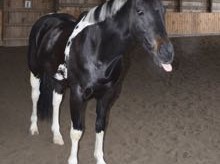At the beginning of June the hens in the new barn got terribly sick, and when a disease hits a flock, it hits hard and fast. Within days every hen – except Prudence – had swollen eyes. Some had eyelids so puffy that they couldn’t see to eat.
A vet diagnosed Mycoplasma gallisepticum, (MG). The bacteria which causes MG is an odd creature; it lacks a cell wall. That means that it is fragile when it is outside of the birds and can be killed with heat, sunlight, disinfectants, or simply time – after 3 days, it dies. But, inside the birds, it is virulent and can lead to severe respiratory disease. Fortunately, I caught it in time before that happened. Also, fortunately, there are drugs that work.
Thanks goodness for drugs. I’m one of those people who buy “antibiotic-free” meat, but I am so grateful that drugs are available to save my pets (and children!) So, don’t even get me started on farmers and doctors who use these sub-therapeutically, creating drug-resistant, highly dangerous, bacteria. (And really don’t get me started on people who chose to travel for their own pleasure, knowing that they could transmit drug-resistant TB!)
Anyway, a vet visit and $200 dollars later, my hens are on Tylan, an antibiotic powder mixed in their water. I also put terramycin ointment in their eyes for a few days. Now, all of the hens look 100% fine. BUT, although MG is easy to kill outside of the body, inside it remains viable for several weeks, even after all symptoms have passed. So, they will remain on the Tylan for 3 weeks, in the hopes of killing it all off. I’ll have to live with the knowledge that my hens might be carriers for the rest of their lives. I won’t take them to shows and I won’t breed them.
There are a few theories about how the MG arrived here at Little Pond Farm. Perhaps Prudence was a carrier; she’s a new hen, and the only one that wasn’t affected. Then again, she stays away from the other hens (who don’t like her at all) and so perhaps, she just didn’t get in contact with the MG (which spreads by touch, not through the air.) My husband thinks that perhaps he was the vector. About a week before the outbreak, he scrubbed out moldy bird feeders and refilled them. He tromped through the barn several times during this task. Wild house finches suffer from MG and it is a likely scenario that he brought it into the barn.
In any event, it is over (for now, at least) and it is a pleasure to go out to the barn and have cheerful, bright-eyed hens greet me.
